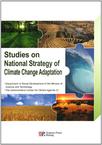适应气候变化国家战略研究
2012-5
科学出版社
中国21世纪议程管理中心 编
188
无
"Studies on National Strategy of Climate Change
Adaptation"(AuthorLi Min、Liu Chao)draws on domestic and
intemational research progresses on the adaptation to climate
change, assesses the current situation and needs to adapt to
climate change, covers the strategies, principles and objectives of
the adaptation, makes clear the problems that may rise from key
areas and different regions due to climate change, and identifies
key tasks and action plans and proposes the comprehensive national
adaptation action plans and capacitybuilding measures. Therefore,
the book can provide reference to national adaptation strategies
and plans,and also help promote China's research, technology
development and application of adaptation technologies and
strengthen the ability to adapt to and address climate change
issues.
"Studies on National Strategy of Climate Change Adaptation" can
be of use for the management of related industries and local
departments, as well as the research and teaching staff in fields
of meteorology, climate,agriculture, forestry, water resources,
marine, energy, human health and other fields.
Foreword
Preface
Abstract
Chapter 1 Current Status of Adaptation to Climate Change in
China
1.1 Status Quo of Climate Change
1.2 China's Social and Economic Development and Future Climate
Change Scenarios
1.3 Overview of the Impacts of Climate Change
1.4 Current Status of Adaptation to Climate Change
1.5 Problems in China's Adaptation to Climate Change
Chapter 2 Needs for and Goals of Adaptation to Climate Change in
China
2.1 Needs for Adaption to Climate Change
2.2 Guidelines and Principles
2.3 Goals of Adaptation to Climate Change
Chapter 3 Key Tasks and Action Plans of Adaptation to Climate
Change in Major Fields
3.1 Overview
3.2 Agriculture
3.3 Water Resources
3.4 Forestry
3.5 Coastal Zones
3.6 Human Health
3.7 Natural Ecosystem and Biodiversity
3.8 Major Projects
3.9 Energy
3.10 Other Areas
Chapter 4 Key Tasks and Action Plans of Adaptation to Climate
Change in Major Regions
4.1 Overview Studies on National Strategy of Climate Change
Adaptation
4.2 Northeast China
4.3 North China
4.4 East China
4.5 Central China
4.6 South China
4.7 Northwest China
4.8 Southwest China
4.9 Qinghal-Tibet Plateau
4.10 China's Sea Areas
Chapter 5 Overall Tasks and Action Plans of Adaptation to Climate
Change at National Level
5.1 Overview
5.2 Key Tasks in Integrated Adaptation to Climate Change
5.3 Action Plans
5.4 Capacity Building and Security Measures
5.5 Conclusion and Outlook
References
Influenced by climate change, many vulnerable natural ecosystems in China aredegrading severely, resulting in its declining functions and rising ecological risks. Inparticular, ecological transition zones, farnung-pastoral zones, tundra, borealforest, alpine pastoral area, river source area, etc. are the most influenced andvulnerable natural ecosystems or areas to climate change. Although climate warmingextends the growing season and the rising concentration of C02 in atmosphere bringsabout " fertilization effect" which increases the productivity of forest ecosystems,extreme weather events, such as temperature rising and drought, may ignite fires,which would decrease the productivity of forest ecosystem. In addition, climatewarming and drying lead to grassland degradation and high frequency of pests,resulting in an annual rate of 2 million hm2 of grassland degraded. As the grasslandecosystem in river source areas are extremely vulnerable, climate warming anddrying result in regional degradation of grassland and wetland, makes meadowsevolved into deserts and alpine swamp meadow turned into alpine steppes and alpinemeadows. Climate change and ecosystem degradation are interacted; the latter wouldreduce local climate functions and makes the local climate more unstable and bringsabout more disasters.3. Climate change reduces biodiversity and some species areendangeredCLimate change decreases the distribution area of some species rapidly, especiallythe small populations distributed narrowly and in special habitats. Some species havebeen extinct due to climate change and human activities in history, such as theXinjiang tiger, Mongolian wild horse, Xinjiang bullhead, Betula halophila birch andclover licorice.Climate change also makes the species dominance changed. For example, in thepast 20 years, climate warming in the north of Greater Khingan Range put lowlandMongolian oak population into a significantly increasing trend, and sprouting seedlingsof natural Haloxylon population in the south of Junggar Basin in Xinjiang sufferedmass mortality and the population is degraded widely. Climate warming decreases themajor coniferous species while increases broad-leaved species. In the next 100 years,forests in the northeast will decline rapidly and coniferous species will be replaced bybroad-leaved species. Moreover, climate change reduces the richness and diversity of some species. Forexample, due to climate warming and drying and human activities, the distributionand composition of animals in the Qinghai Lake Region has undergone a significantchange: 26 species of birds have disappeared in the lake district since the mid-20ulcentury, and lake ibex, Tibetan wild ass, leopard cat, lynx, wild yak, Tibefanantelope have also disappeared from the surrounding areas.ln addition, Przewalski'sgazelle, originally distributed in Inner Mongolia, Qinghai and Gansu, are found onlyin the Qinghai Lake Region.4. Harmful biological invasions pose serious threaten to ecosystemsand biodiversityBiological invasion refer to a process of any alien organisms, which posethreats to native ecosystems, habitats, species and human health, spreading to another environment through natural or artificial channels, settling, reproducing and spreading in the local natural or artificial ecosystems, and eventually affectingthe local ecological environment significantly and damaging its biodiversity andhuman health.With economic globalization and climate change, biological invasion hasbecome increasingly prominent, and posed severe threats to natural ecosystems,biodiversity, agricultural production and human health in China. At present, Chinahas more than 580 open ports, where a large number of invasive species areintercepted each year. The number of species intercepted has been increased fromhundreds in the 1980's to nearly 2000 in the year 2003, and the number ofinterception has soared from thousands to more than 50,000 each year. A dozenof invasive organisms, such as pine wood nematode, potato beetle and Mikaniamicrantha plant, cause dozens of billions of economic losses annually. Among the 100most threatening alien species published by the International Union for Conservation ofNature(IUCN) , more than 50 of them can be found in China, including pine woodnematode and Hyphantria cunea, and biological invasion has emerged in almost alltypes of ecosystems in China. ……

无